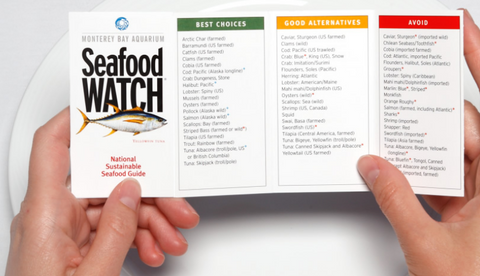We are as connected to the oceans and the life in them as we are to the oxygen we breathe in every day. One of the things the oceans provide us is oxygen! That is, aside from fish and all the wonderful marine life keeping the planet alive.
But oceans are under a combined threat. Acidification, warming, and overfishing are just three of the major pressures felt by ocean life today. The report generated at the end of last year by the International Programme on the State of the Oceans (IPSO)1 describes a reality few are prepared to accept: that changes in the ocean are happening faster, they are having a more significant impact, and the effects are more imminent than previously anticipated.

Not everyone can save an entire ocean from every single danger, but we can better examine our consumption of fish.
There was a time when no one had to worry about fish--other than how to catch it and how to use it before it went bad! Because there was a lot of it. Sharing with the community did the job. The excess was traded.
Then came industrialization and with it pollutants. People realized that fish may carry environmental pollutants such as polychlorinated biphenyls (PCBs) or heavy metals such as mercury (Hg) (and some more than others.) Safety concerns intertwined with overfishing prompted many to realize that irreparable damage to the oceans may be lurking near.
The grimmest prediction is that by 2050 the oceans will be depleted of most of the fish. “Empty” is one hollow word when it applies to oceans once full of fish.
No wild fish, no problem, some might say. Can fish farming solve the problem?
Some farmed fish, such as the Coho salmon, arctic char, tilapia and rainbow trout are listed as best choices by seafood watchdogs. Some of the farmed seafood though--such as the Atlantic salmon and shrimp and prawn farmed anywhere but in the US--leaves an environmental imprint that is long-lasting and damaging; they pollute the oceans, causing algae growth and oxygen depletion to the point of turning some areas into “dead zones.”2
Perhaps eating less fish?
That might solve the problem. This is true enough for certain regions where fish is but one of the protein sources. But what about the rest of the world? The situation could turn suddenly dire for certain people in regions where they rely on seafood as an essential protein source.
Additionally, illegal fishing takes an extra heap of fish from the ocean and it is not a small one. Some of the fish could be large fish that reproduce later in life--something they may never happen if fished before their time. “By-catch” that receives no attention but is dumped back in the ocean represents a sad loss that adds to overfishing as well.
The list does not stop here. There is habitat destruction due to some fishing methods that “rake” the seafloor, ocean warming & acidification, and sea mining. They all cause fish stocks to decline.
Can we still eat fish? Could it be done in a sustainable manner? How about toxic substances that can inadvertently land on your plate?
Yes, yes, and most pollutants and pollutants in high concentration can be avoided. For now.
How to choose fish:
- Stick with the ones situated lower in the food chain. Fish eating other fish have a higher content of pollutants than those eating seaweed or plankton.
- Avoid king mackerel, tilefish, swordfish and tuna. Also, avoid farmed Atlantic salmon.
- Consult the well-researched, extensive lists provided by the Monterey Bay Aquarium Seafood Watch®3 in collaboration with Canadian-based Seachoice4.
As with the rest of your lifestyle choices, the choice of seafood extends way beyond of what’s directly safe for you and your family. Every morsel of fish we eat has an impact on the oceans we dreamily gaze over. As always, we have both choice and responsibility.
Learn more about how bambu has partnered with Monterey Bay Aquarium Seafood Watch® here.
Notes:





